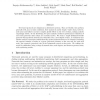Free Online Productivity Tools
i2Speak
i2Symbol
i2OCR
iTex2Img
iWeb2Print
iWeb2Shot
i2Type
iPdf2Split
iPdf2Merge
i2Bopomofo
i2Arabic
i2Style
i2Image
i2PDF
iLatex2Rtf
Sci2ools
CORR
2010
Springer
2010
Springer
The Accuracy of Tree-based Counting in Dynamic Networks
Tree-based protocols are ubiquitous in distributed systems. They are flexible, they perform generally well, and, in static conditions, their analysis is mostly simple. Under churn, however, node joins and failures can have complex global effects on the tree overlays, making analysis surprisingly subtle. To our knowledge, few prior analytic results for performance estimation of tree based protocols under churn are currently known. We study a simple Bellman-Ford-like protocol which performs network size estimation over a tree-shaped overlay. A continuous time Markov model is constructed which allows key protocol characteristics to be estimated, including the expected number of nodes at a given (perceived) distance to the root and, for each such node, the expected (perceived) size of the subnetwork rooted at that node. We validate the model by simulation, using a range of network sizes, node degrees, and churn-to-protocol rates, with convincing results.
| Added | 09 Dec 2010 |
| Updated | 09 Dec 2010 |
| Type | Journal |
| Year | 2010 |
| Where | CORR |
| Authors | Supriya Krishnamurthy, John Ardelius, Erik Aurell, Mads Dam, Rolf Stadler, Fetahi Wuhib |
Comments (0)

